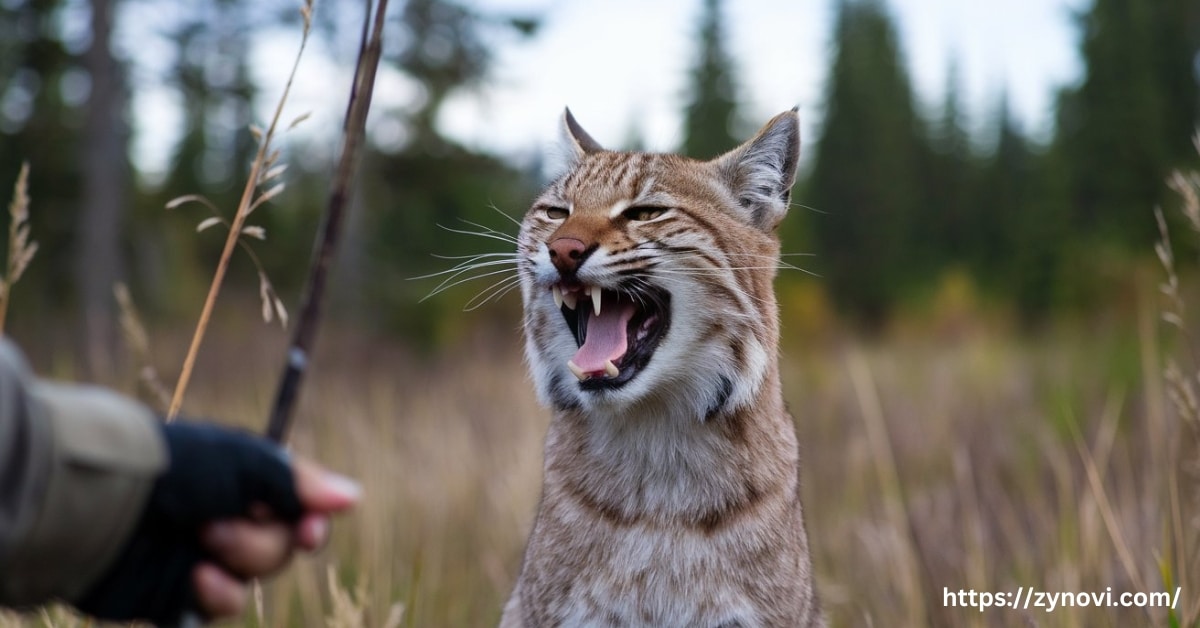Do Bobcats Attack Humans? If you’ve ever wondered about the safety of encountering a bobcat, you’re not alone. These elusive wildcats are often spotted in forests, suburbs, and even urban areas, leaving many to question if they pose a threat to humans.
Do bobcats attack people? are rare, understanding their behavior and the risks involved is essential for staying safe.
In this article, we’ll explore what makes bobcats tick, how to protect yourself in case of an encounter, and when to take action. Let’s dive in and uncover the truth behind these fascinating creatures!
Who Is the Bobcat?
Physical Characteristics
The bobcat is a medium-sized wildcat typically weighing between 15-35 pounds, with males generally larger than females. They measure about 2-4 feet in length, including their characteristic short tail.
Key physical traits include:
- Tufted ears with black tips, aiding their sharp hearing.
- Short “bobbed” tail, usually 4–7 inches long, giving them their name.
- A spotted coat that provides excellent camouflage in forests and deserts.
- Powerful legs and paws, which enable them to leap as high as 12 feet.
| Feature | Description |
|---|---|
| Weight | 15–35 pounds |
| Length | 2–4 feet |
| Tail | Short, 4–7 inches |
| Coat | Spotted, with variations by habitat |
| Lifespan | 7–10 years in the wild; up to 20 in captivity |
Habitat and Range
Bobcats thrive in diverse environments, from forests, swamps, and deserts to urban areas. Their adaptability has allowed them to coexist with humans, particularly in suburban regions where food and shelter are accessible.
- Geographic Range: Found across North America, from southern Canada to northern Mexico.
- Urban Adaptation: Increasingly sighted in cities due to habitat encroachment.
Bobcats prefer habitats with dense vegetation but are equally comfortable in open areas like farmland, highlighting their resourcefulness.
Bobcat Behavior and Interaction with Humans
Natural Diet and Hunting Habits
Bobcats are carnivorous predators, primarily preying on small mammals like rabbits and rodents. However, their diet can vary based on availability, including birds, reptiles, and occasionally young deer.
Key hunting traits:
- Solitary ambush hunters with exceptional sight and hearing.
- Active primarily at dawn and dusk (crepuscular behavior).
- Ability to stalk prey silently, leveraging their stealth and camouflage.
Bobcats in Urban and Suburban Areas
Urban expansion has brought bobcats into closer proximity with humans. They’re attracted to cities by:
- Food Sources: Pet food, garbage, or small animals.
- Shelter: Brush piles, abandoned buildings, and dense shrubbery.
Despite their presence, urban bobcats typically avoid direct interaction with people.
Are Bobcats Attack Humans? Realities and Misconceptions

Rabid Bobcat Attacks
Will a bobcat attack a human? While attacks are rare, rabies can make them unusually aggressive and dangerous. Infected bobcats may lose their fear of humans, increasing the risk of an encounter.
- Signs of a rabid bobcat include erratic movements, often appearing disoriented or distressed.
- Another symptom is unprovoked aggression, where the bobcat attacks without any clear threat.
- Foaming at the mouth is a common rabies indicator, requiring immediate caution and reporting to authorities.
Tip: If bitten or scratched, seek immediate medical attention to prevent rabies complications.
Provoked Attacks
A provoked bobcat attack happens when the animal perceives a direct threat, causing it to act defensively. These attacks are usually avoidable with caution.
The Animal is Cornered or Feels Threatened Bobcats may lash out if they feel trapped or have no escape route, relying on aggression for self-defense.
A Mother Bobcat is Protecting Her Young A mother bobcat will become highly defensive when her kittens are nearby, attacking anything she sees as a threat.
To Avoid Provoking Bobcats Keep a safe distance and never corner them, as this increases their sense of danger. Avoid feeding or attempting to interact with wild bobcats to minimize risks.
Misidentification and Myths
Not all wild cat encounters involve bobcats. Other predators, such as lynx or coyotes, are often misidentified. Unlike lynx, bobcats are more adaptable to human environments, while coyotes are typically less elusive.
Myth: Bobcats commonly kill humans.
Fact: No verified records of unprovoked fatal bobcat attacks exist.
Understanding Bobcat Behavior

Territorial Nature
Bobcats are highly territorial, using distinct markers to establish and defend their range. This behavior helps reduce conflict with other animals and humans.
Urine and Feces Bobcats use urine and feces to signal their presence, creating clear boundaries for other animals in the area.
Scratch Marks on Trees Claw marks on trees or logs serve as visual and scent markers, reinforcing territorial claims.
This territorial behavior is vital for minimizing unnecessary interactions with other bobcats and nearby humans.
Nocturnal and Solitary Lifestyle
Bobcats exhibit nocturnal and crepuscular behavior, being most active during twilight hours. Their solitary lifestyle further reduces encounters with humans.
Did you know? Bobcats can travel up to 7 miles in a single night while hunting!
Defensive Behaviors Bobcats rely on defensive tactics to deter threats and protect themselves when they feel endangered. Recognizing these behaviors can prevent escalation during encounters.
Hissing and Growling These vocalizations are warning signals that the bobcat feels threatened and wants the perceived danger to retreat.
Puffing Up Their Fur to Appear Larger Bobcats make themselves look bigger to intimidate predators or threats, creating the illusion of greater strength.
Swiping with Sharp Claws Quick, powerful swipes are used as a last resort to fend off close-range threats effectively.
Understanding these defensive signals can help humans avoid provoking an aggressive response.
What to Do If You Encounter a Bobcat
Here’s how to handle a bobcat encounter safely:
- Stay Calm: Avoid sudden movements.
- Make Yourself Bigger: Raise your arms and stand tall.
- Use Noise to Deter: Clap, shout, or use a whistle.
- Back Away Slowly: Never turn your back or run.
- Protect Pets: Keep small pets indoors or on a leash.
Pro Tip: Carry a flashlight or pepper spray when hiking in bobcat territory.
Living in Bobcat Territory
Preventive Measures to Protect Pets and Livestock
Taking precautions can help protect pets and livestock from occasional bobcat attacks, ensuring their safety.
Install Secure Fencing at Least 6 Feet High A tall, solid fence prevents bobcats from jumping into areas where pets or livestock are kept, acting as a barrier to entry.
Use Motion-Sensor Lights Around Pet Areas Motion sensor lights can startle bobcats and other predators, deterring them from approaching your property.
Keep Livestock in Enclosed Shelters at Night Bringing livestock into secure shelters at night reduces their vulnerability when bobcats are more active and hunting.
Tips for Keeping Bobcats Away from Property
Taking proactive steps can help deter bobcats from coming too close to your home or property.
Secure Garbage: Use Wildlife-Proof Bins Bobcats are often attracted to food waste; using secure bins prevents them from scavenging.
Remove Attractants: Eliminate Outdoor Food Sources Avoid leaving pet food, birdseed, or fallen fruit outside, as these can attract bobcats looking for an easy meal.
Trim Vegetation: Reduce Hiding Spots by Maintaining Your Yard Keep bushes and tall grass trimmed to remove potential hiding spots for bobcats, making your property less inviting.
FAQs
Are bobcats dangerous to pets?
Yes, small pets like cats and dogs can be vulnerable. Always supervise pets outdoors.
Can bobcats kill humans?
Unlikely. Unprovoked attacks on humans are extremely rare.
How can I keep bobcats away from my property?
Use deterrents like motion-sensor lights, secure garbage bins, and eliminate food sources.
Can bobcats climb trees?
Yes, bobcats are excellent climbers, often escaping predators by ascending trees.
Are bobcats protected by law?
Yes, hunting or trapping bobcats typically requires permits and varies by state.
Conclusion: Do Bobcats Attack Humans?
While bobcats rarely attack humans, understanding their behavior ensures safer coexistence. These solitary, elusive wildcats play a crucial role in ecosystems by controlling rodent populations. With preventive measures and awareness, living near bobcats can be both safe and fascinating.
Quote: “Respect wildlife by understanding their needs, and you’ll unlock the secrets of coexistence.”
By dispelling myths and focusing on facts, we pave the way for a harmonious relationship with these beautiful predators.










